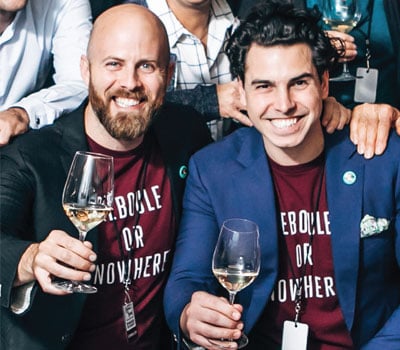In the spring of 2016, NoMad sommelier Thomas Pastuszak and Verve Wine’s Dustin Wilson, MS, were sitting with André Perret in the village of Verlieu-Chavanay, tasting some of Perret’s St-Joseph cuvées. “I love how, in America, there are these great celebrations around wine from different regions,” Perret mentioned. “Burgundy, Champagne, German riesling… It’s a shame that we don’t see anything like that for the northern Rhône.”


“We thought we were just going to get a bunch of collectors,” adds Pastuszak. “But we found that even people who had just had their first taste of the region were wanting to come to the event.”
Across the country, it turns out, sommeliers are reporting that enthusiasm for the northern Rhône is starting to escape its culty wine-insider bubble. Part of that interest, certainly, is the result of producers from South Africa to Australia to the Sonoma Coast preaching the gospel of cool-climate syrah through their own savory, aromatic wines. But these days, the gateway to syrah is often much closer to Lyon.
When trying to explain why so many sommeliers adore syrah while so many casual wine drinkers remain gun-shy, many in the trade talk about its muddled identity: There were the savory, trim northern Rhône wines, and then along came the bombastic Aussie-inspired critter wines and their ilk, and between the two, most wine drinkers simply got confused.
Wilson, though, speculates that part of the challenge was simply the nature of the grape, even in its ideal form. “It was easy for consumers to understand pinot and cabernet,” he says. “But syrah? It had acidity and was very savory, but was also very dark in color. It was not a full-bodied wine, but not a light-bodied wine, either, and not a fruity style of wine.”
Lately, his clientele seems to be wrapping their heads around it. “I have lots of customers coming in and asking for syrah, or asking for wines from the northern Rhône,” he observes. He points to St- Joseph, in particular, as a bright spot: As the legendary bottlings from Hermitage and Côte-Rôtie and even Cornas become rare commodities, a new generation of hungry vignerons and small négociants from less heralded ground is making an impact.
“You have these wines that are super delicious and very terroir-specific, at accessible prices, so the excitement around the region is still growing,” he finds.
At Le Coucou, a 15-minute walk east of Verve’s Manhattan location, wine director Charles Puglia has been selling more than a few northern Rhône wines, from a list that’s not short on other Francophile pleasures, including Champagne, old Bordeaux and Burgundy. And he, too, points a finger squarely at St-Joseph, particularly at a somewhat lesser-known producer, Monier-Perréol.
“As soon as I bring in a case or two of each cuvée, within a month they’re pretty much all gone,” he says. “And then I have to wait a year for my next allocation. These guests are completely wide-eyed about it: ‘I can’t believe a wine like this exists.’ [This is] a producer that has just seven hectares, all in St-Joseph.”
They’re not trophy wines, Puglia points out. The most expensive cuvée sits at around $140 on his list. “At Reboule, I got to chat with Monsieur Perréol, and he was stunned that his wines have this cult following in New York City,” Puglia adds.
The interest extends well beyond the confines of Manhattan.
Less than a year ago, sommelier Josh Thomas left San Francisco to open Maverick, a brasserie in San Antonio. His wine program pushes the edges of that city’s comfort zone, and yet he’s been surprised by the success of the northern Rhône wines he loves. “We sell more northern Rhône and California syrah than grenache, for sure,” he says—a far cry from his early days working in retail, when big, sappy, Robert Parker–endorsed grenache wines were king.
Back in San Francisco, northern Rhône syrahs are especially plentiful at Angler, which Esquire recently named the best new restaurant in the country—the list includes more than 50 bottlings of Côte-Rôtie. But J. L. Chave’s relatively affordable St-Joseph was the lone syrah on a recent by-the-glass list, and head sommelier Morgan Harris agrees that it’s the more modestly priced wines from the northern Rhône that are likely to serve as syrah’s ultimate gateway drugs: “You can easily go out to a restaurant and drink good Crozes-Hermitage or St-Joseph for well under a hundred dollars a bottle.”
It’s the reactions he’s seen to those wines, in turn, that make him optimistic about the prospects of northern Rhône–inspired wines from New World regions like Australia’s Yarra Valley and the far Sonoma coast. “New World syrah is one of the first sections of the list I’ll be expanding, as far as reds are concerned,” he says.
This story was featured in W&S February 2019.
Longtime senior editor at Wine & Spirits magazine, Luke now works for the Stanford Technology Ventures Program.
This story appears in the print issue of February 2019.
Like what you read? Subscribe today.
















